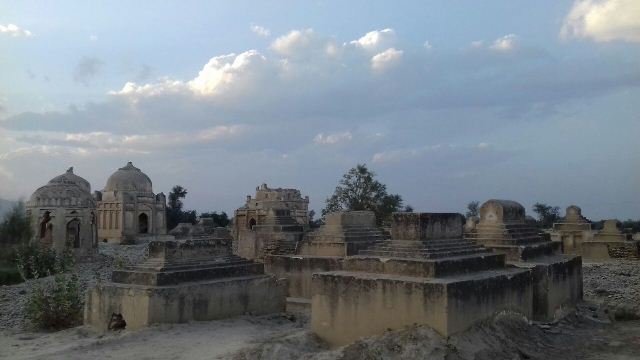
The beauty and grandeur of the tomb has vanished as the archeological department has failed to restore the masterpiece.
All the Quranic texts, calligraphy and historical paintings have been completely destroyed as repair has not been carried out for years.
A few decades ago, the verses of the Holy Quran transcribed on the tiles and walls of the tomb were obvious, but now due to negligence of the government, those writings are no longer visible.
Nawab Saeed Khan Qureshi belonged to Multan and spent 29 years of his life on the streets of the city. He was a chronicler— the journalists of the day—in the era of Mughal King Jahangir.
He was assigned an important post in Multan during the reign of Emperor Jahangir who ruled the subcontinent from 1605 to 1627. Being a close confidant of Multan Governor Prince Murad Bakhsh, he also served as adviser during the era of Emperor Shah Jahan.
After serving in Multan, he was transferred to Gujrat for a short period of time, but later returned to the historic city. He died in 1677AD and was buried in a mausoleum which was built by him in the corner of his palace garden. He also constructed a mosque near his mausoleum. Qureshi had rich taste in poetry and literature and won the appreciation of two great Mughal princes, namely Murad Bakhsh and Aurangzeb Alamgir.
The tomb that was originally built in the midst of a vast garden full of colorful flowers and fountains, with palaces all around, is in dire need of restoration. With the passage of time, all the gardens and palaces have vanished and the structure is now surrounded by homes.
The historic building is the last remnant of Mughal architecture in downtown Multan which has witnessed harsh weather conditions and destruction from time to time.
The tomb is situated at a place where a lot of people and passersby ignore it due to the dilapidated condition. However, there are still a large number of believers in the neighborhood who lay wreaths on the grave of Nawab Saeed Khan Qureshi and pray at the shrine.
Locals and social activists have demanded the renovation of the mausoleum on a war-footing basis.
While speaking to The Express Tribune, civil society activist Farah Gurmani said that the tomb should be reconstructed to its original form as it was a relic of Mughal era. “The restoration of such a historical structure is important to educate young generations about the pride and glory of Muslim emperors in the subcontinent,” she added.
She maintained that Multan is a historical city and its history dates back to more than 5,000 years. “I remained an important fort to avert Hindu and Sikh invasions. Its historical importance can only be maintained by restoring it to its former glory,” Gurmani pointed out.
When contacted, Archaeology Department Assistant Director Ghulam Malik said that the archeology department has received a lot of applications for the restoration of shrine of Nawab Saeed Khan. “The government has allocated Rs170 million for the conservation and restoration of historical buildings of South Punjab under the Annual Development Plan of 2018-19.”
He pointed out that the archaeology department has sent a proposal to the relevant authorities for the restoration of mausoleum of Nawab Saeed Khan Qureshi and the renovation would start as soon there is an approval.
Published in The Express Tribune, June 11th, 2018.
























1714024018-0/ModiLara-(1)1714024018-0-270x192.webp)









COMMENTS (1)
Comments are moderated and generally will be posted if they are on-topic and not abusive.
For more information, please see our Comments FAQ